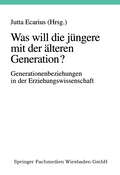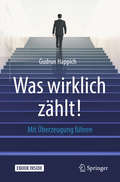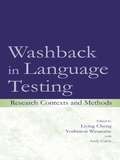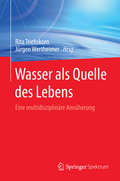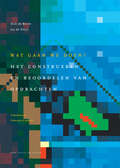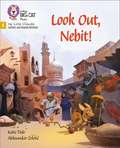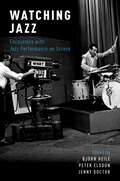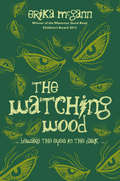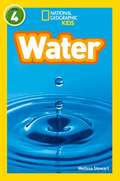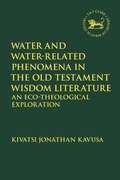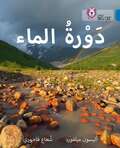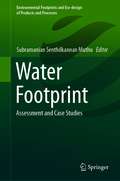- Table View
- List View
Was will die jüngere mit der älteren Generation?: Generationsbeziehungen und Generationenverhältnisse in der Erziehungswissenschaft
by Jutta EcariusWas wirklich zählt!: Mit Überzeugung führen
by Gudrun HappichAn der Spitze stehen, erfolgreich sein und sich trotzdem ohnmächtig, überfordert, unzufrieden und einsam zu fühlen – das kommt häufiger vor als manche glauben. Warum? Um Erfolg und Erfüllung verbinden zu können, benötigen wir den richtigen Platz, der unseren Stärken und Talenten entspricht. Ähnlich wie Pflanzen verkümmern wir, wenn die Rahmenbedingungen uns nicht entsprechen. Wenn wir dagegen unser (Berufs-) Leben im Einklang mit unserer inneren Überzeugung gestalten, können wir Leistung mit Leidenschaft und Leichtigkeit verbinden. In diesem Buch lernen Sie vier Top-Führungskräfte kennen. Ihre Karrieren, Ängste, Zweifel und Hoffnungen sind exemplarisch für viele andere. Begleiten Sie sie dabei, wie sie ihren persönlichen Weg zu Erfolg und Erfüllung gehen und machen Sie sich selbst auf den Weg. Sie finden dazu viele Praxis-Tipps und Übungen. Von der vielfach bewährten Vorgehensweise profitieren der Einzelne und das Unternehmen – denn Mensch und System lassen sich nicht trennen. Ein Mensch in der falschen Position kann ein ganzes Unternehmen gefährden. Andersherum: Wer wirklich überzeugt ist, von dem was er tut, hat immer Erfolg – und Spaß daran.Dieses Sachbuch ist eine Weiterentwicklung des erfolgreichen Fachbuchs "Was wirklich zählt!", Springer Gabler 2014.
Washback in Language Testing: Research Contexts and Methods
by Liying Cheng Yoshinori Watanabe Andy CurtisWashback refers to the influence of language testing on teaching and learning. This volume, at the important intersection of language testing and teaching practices, presents theoretical, methodological, and practical guidance for current and future washback studies. In the field of language testing, researchers' major interest has traditionally been focused on issues and solving problems inherent in tests in order to increase their reliability and validity. However, the washback effect goes well beyond the test itself to include factors, such as curriculum, teacher and learner behaviors inside and outside the classroom, their perceptions of the test, and how test scores are used. Only recently have researchers started to empirically investigate the phenomenon of washback. This volume of such research serves two essential purposes by:*providing an overview of the complexity of washback and the various contextual factors entangled within testing, teaching, and learning; and *presenting empirical studies from around the world that offer insights into the effects of washback in specific educational contexts and models of research on which future studies can be based. The extensive use of test scores for various educational and social purposes in society nowadays makes the washback effect a high-interest phenomenon in the day-to-day educational activities of teachers, researchers, program coordinators/directors, policymakers, and others in the field of education. Washback in Language Testing: Research Contexts and Methods is a valuable resource for those who are interested in the application of findings to actual teaching and learning situations or conduct washback research in their own contexts, including educational and psychological testing experts, as well as alternative assessment people in all fields, and for policy- and decision-makers in educational and testing organizations.
Washback in Language Testing: Research Contexts and Methods
by Liying Cheng Yoshinori Watanabe With Andy CurtisWashback refers to the influence of language testing on teaching and learning. This volume, at the important intersection of language testing and teaching practices, presents theoretical, methodological, and practical guidance for current and future washback studies. In the field of language testing, researchers' major interest has traditionally been focused on issues and solving problems inherent in tests in order to increase their reliability and validity. However, the washback effect goes well beyond the test itself to include factors, such as curriculum, teacher and learner behaviors inside and outside the classroom, their perceptions of the test, and how test scores are used. Only recently have researchers started to empirically investigate the phenomenon of washback. This volume of such research serves two essential purposes by:*providing an overview of the complexity of washback and the various contextual factors entangled within testing, teaching, and learning; and *presenting empirical studies from around the world that offer insights into the effects of washback in specific educational contexts and models of research on which future studies can be based. The extensive use of test scores for various educational and social purposes in society nowadays makes the washback effect a high-interest phenomenon in the day-to-day educational activities of teachers, researchers, program coordinators/directors, policymakers, and others in the field of education. Washback in Language Testing: Research Contexts and Methods is a valuable resource for those who are interested in the application of findings to actual teaching and learning situations or conduct washback research in their own contexts, including educational and psychological testing experts, as well as alternative assessment people in all fields, and for policy- and decision-makers in educational and testing organizations.
Wasser als Quelle des Lebens: Eine multidisziplinäre Annäherung
by Rita Triebskorn Jürgen WertheimerAls Forschungsgegenstand der Natur-, Sozial-, Geisteswissenschaften wie auch der Medizin ist Wasser als Quelle des Lebens Thema dieses breit gefächerten, interdisziplinären Werkes. Der Bogen spannt sich vom Wassermolekül als Baustein alles Lebendigen über das Wasser im Wechsel der Jahreszeiten und der Aggregatzustände, als Zivilisationsgarant und seltenes Gut hin zum Wasser als spirituelle Quelle, religiöses Symbol, Medium und Metapher.Das Werk leistet einen thematischen Beitrag zu der von den Vereinten Nationen ausgerufenen Internationalen Aktionsdekade „Wasser für das Leben“.
Wasted: Why Education Isn't Educating
by Frank FurediNever has so much attention been devoted to education. Everyone - government ministers, social commentators and parents obsess about its problems. Yet we rarely ask why? Why is education a source of such concern? Why do many of the solutions proposed actually make matters worse?Tony Blair's 'education, education, education' slogan placed education at the forefront of political agendas. But, perhaps the 'policisation' of education is part of the problem. Today, education is valued for its potential contribution to economic development, but it is no longer considered important for itself. Increasingly, the promotion of education has little to do with the value of learning per se or with the importance of 'being taught' about societies' achievements, so future generations have the intellectual ability to advance still further. Education has been emptied of its content.This book is a brilliant piece of analysis. It peers into the hollowness of the education debates and, drawing on thinkers from the ancient Greeks to modern critics, it sets out what we need from our schools.
Wasted: Why Education Isn't Educating
by Frank FurediNever has so much attention been devoted to education. Everyone - government ministers, social commentators and parents obsess about its problems. Yet we rarely ask why? Why is education a source of such concern? Why do many of the solutions proposed actually make matters worse?Tony Blair's 'education, education, education' slogan placed education at the forefront of political agendas. But, perhaps the 'policisation' of education is part of the problem. Today, education is valued for its potential contribution to economic development, but it is no longer considered important for itself. Increasingly, the promotion of education has little to do with the value of learning per se or with the importance of 'being taught' about societies' achievements, so future generations have the intellectual ability to advance still further. Education has been emptied of its content.This book is a brilliant piece of analysis. It peers into the hollowness of the education debates and, drawing on thinkers from the ancient Greeks to modern critics, it sets out what we need from our schools.
Wasted Education: How We Fail Our Graduates in Science, Technology, Engineering, and Math
by John D. SkrentnyAn urgent reality check for America’s blinkered fixation on STEM education. We live in an era of STEM obsession. Not only do tech companies dominate American enterprise and economic growth while complaining of STEM shortages, but we also need scientific solutions to impending crises. As a society, we have poured enormous resources—including billions of dollars—into cultivating young minds for well-paid STEM careers. Yet despite it all, we are facing a worker exodus, with as many as 70% of STEM graduates opting out of STEM work. Sociologist John D. Skrentny investigates why, and the answer, he shows, is simple: the failure of STEM jobs. Wasted Education reveals how STEM work drives away bright graduates as a result of “burn and churn” management practices, lack of job security, constant training for a neverending stream of new—and often socially harmful—technologies, and the exclusion of women, people of color, and older workers. Wasted Education shows that if we have any hope of improving the return on our STEM education investments, we have to change the way we’re treating the workers on whom our future depends.
Wasted Education: How We Fail Our Graduates in Science, Technology, Engineering, and Math
by John D. SkrentnyAn urgent reality check for America’s blinkered fixation on STEM education. We live in an era of STEM obsession. Not only do tech companies dominate American enterprise and economic growth while complaining of STEM shortages, but we also need scientific solutions to impending crises. As a society, we have poured enormous resources—including billions of dollars—into cultivating young minds for well-paid STEM careers. Yet despite it all, we are facing a worker exodus, with as many as 70% of STEM graduates opting out of STEM work. Sociologist John D. Skrentny investigates why, and the answer, he shows, is simple: the failure of STEM jobs. Wasted Education reveals how STEM work drives away bright graduates as a result of “burn and churn” management practices, lack of job security, constant training for a neverending stream of new—and often socially harmful—technologies, and the exclusion of women, people of color, and older workers. Wasted Education shows that if we have any hope of improving the return on our STEM education investments, we have to change the way we’re treating the workers on whom our future depends.
Wat gaan we doen?: Het construeren en beoordelen van opdrachten : praktijkboek bij Onderwijs als opdracht (Docentenreeks)
by D. de Bie Hamer Soft: Kleijn, de J.De gangbare onderwijspraktijk bevalt niet.' 'Vuur en enthousiasme ontbreken bij het leren.' 'Elan ontbreekt bij het onderwijzen.' Deze kritische uitspraken zijn voor Dick de Bie en Jos de Kleijn het startpunt voor hun boek Wat gaan we doen? Het construeren en beoordelen van opdrachten. Zij laten op een inspirerende manier zien hoe je als docententeam een onderwijsprogramma kan inrichten met behulp van opdrachten.De auteurs zetten eerst duidelijk uiteen wat er achter een opdracht steekt en wat de grote betekenis is van dynamiek in een leerproces. Daarna komt de constructie van opdrachten in diverse leerprocessen aan bod. Voor de beoordeling van opdrachten doen de auteurs een aantal verrassende suggesties. Het boek sluit af met een hoofdstuk over het werken met opdrachten voor docenten.Wat gaan we doen? is een praktijkboek, geschreven vóór en vanuit de onderwijspraktijk. Het biedt docenten en leidinggevenden inspiratie en ondersteuning om studenten echt te laten leren. Leren is dóen, 'doen met verstand'. Bestemd voor… docenten en leidinggevenden; studenten aan lerarenopleidingen.
Watch It: The Risks And Promises Of Information Technologies For Education
by Nicholas BurbulesWatch IT is an examination of several critical issues in the potential of new information technology (IT) for education. IT, already central to many aspects of our lives, is rapidly becoming an integral part of teaching and learning. This book takes a close look at the positive and negative consequences of new technologies in the classroom. In a series of interrelated essays, the authors explore such issues as access, credibility, new approaches to reading and writing, the glut of information, privacy, censorship, commercialization, and globalization.
Watch It: The Risks And Promises Of Information Technologies For Education
by Nicholas BurbulesWatch IT is an examination of several critical issues in the potential of new information technology (IT) for education. IT, already central to many aspects of our lives, is rapidly becoming an integral part of teaching and learning. This book takes a close look at the positive and negative consequences of new technologies in the classroom. In a series of interrelated essays, the authors explore such issues as access, credibility, new approaches to reading and writing, the glut of information, privacy, censorship, commercialization, and globalization.
Watch Out, Nebit!: Phase 5 (Big Cat Phonics For Little Wandle Letters And Sounds Revised Ser.)
by Katie Dale Aleksandar Zolotic Collins Big CatCollins Big Cat Phonics for Letters and Sounds features exciting fiction and non-fiction decodable readers to enthuse and inspire children. They are fully aligned to Letters and Sounds Phases 1-6 and contain notes in the back. The Handbooks provide support in demonstration and modelling, monitoring comprehension and expanding vocabulary. Dive into the world of Ancient Egypt with a young narrator and their naughty dog Nebit, racing through the streets and causing havoc as they go! This energetic and funny story is written by Katie Dale. Orange/Band 6 books offer varied text and characters, with action sustained over several pages. The focus sounds in this book are: /f/ ph /w/ wh /ee/ e-e, e, y /igh/ y /ch/ tch /j/ g, ge, dge /l/ le /z/ se /sh/ ch /ai/ a Pages 22 and 23 allow children to re-visit the content of the book, supporting comprehension skills, vocabulary development and recall. Reading notes within the book provide practical support for reading Big Cat Phonics for Letters and Sounds with children, including a list of all the sounds and words that the book will cover. This book has been quizzed for Accelerated Reader.
Watching Jazz: Encounters with Jazz Performance on Screen
by Bjö Heile Peter Elsdon Jenny DoctorWatching Jazz: Encounters with Jazz Performance on Screen is the first systematic study of jazz on screen media. Where earlier studies have focused almost entirely on the role and portrayal of jazz in Hollywood film, the present book engages with a plethora of technologies and media from early film and soundies through television to recent developments in digital technologies and online media. Likewise, the authors discuss jazz in the widest sense, ranging from Duke Ellington and Jimmy Dorsey through the likes of Dizzy Gillespie, Art Blakey, Oscar Peterson, Miles Davis, John Coltrane and Charles Mingus to Pat Metheny. Much of this rich and fascinating material has never been studied in depth before, and what emerges most clearly are the manifold connections between the music and the media on which it was and is being recorded. Its long association with film and television has left its trace in jazz, just as online and social media are subtly shaping it now. Vice versa, visual media have always benefited from focusing on music and this significantly affected their development. The book follows these interrelations, showing how jazz was presented and represented on screen and what this tells us about the music, the people who made it and their audiences. The result is a new approach to jazz and the media, which will be required reading for students of both fields.
WATCHING JAZZ C: Encounters with Jazz Performance on Screen
by Björn Heile, Peter Elsdon, and Jenny DoctorWatching Jazz: Encounters with Jazz Performance on Screen is the first systematic study of jazz on screen media. Where earlier studies have focused almost entirely on the role and portrayal of jazz in Hollywood film, the present book engages with a plethora of technologies and media from early film and soundies through television to recent developments in digital technologies and online media. Likewise, the authors discuss jazz in the widest sense, ranging from Duke Ellington and Jimmy Dorsey through the likes of Dizzy Gillespie, Art Blakey, Oscar Peterson, Miles Davis, John Coltrane and Charles Mingus to Pat Metheny. Much of this rich and fascinating material has never been studied in depth before, and what emerges most clearly are the manifold connections between the music and the media on which it was and is being recorded. Its long association with film and television has left its trace in jazz, just as online and social media are subtly shaping it now. Vice versa, visual media have always benefited from focusing on music and this significantly affected their development. The book follows these interrelations, showing how jazz was presented and represented on screen and what this tells us about the music, the people who made it and their audiences. The result is a new approach to jazz and the media, which will be required reading for students of both fields.
The Watching Wood
by Erika McGannDanger wherever you turn … When Grace and her five best friends are sucked into a world of witches and faeries, it seems like a nightmare. Forced to take part in the Witch Trials, they risk life and limb to compete against other trainee witches in magical, death-defying stunts. But when they are discovered to be mere humans, this supernatural world turns against them, and the real nightmare begins. Caught in the middle of an ancient and bloody feud, Grace must outwit powerful witches, avoid the clutches of menacing faeries, and bring her friends back together. But have the girls enough power between them to make it back home?
Watching You, Watching Me (Back-2-Back #2)
by Chloe RaybanThere are two sides to every story and this new series, BACK-2-BACK, is designed to attract both boys and girls. Teenagers will love to read what she really thinks about him and what he really thinks about her!
Watchwords: Mark 13 in Markan Eschatology (Bloomsbury Academic Collections: Biblical Studies)
by Timothy GeddertMark has written a remarkable Gospel. Deceptively simple on the surface, its mystery and ambiguity have intrigued and challenged scholar and lay reader alike. Through veiled clues, controlled word usage and carefully contrived ambiguity, Mark embeds profound theological reflections in the stories he tells. The eschatological discourse (Mark 13) is a prime example. Modern scholars have attempted in vain to eliminate the ambiguities of Mark 13. Does Mark expect the End to come very soon? What is the relationship between the Fall of the Temple and the End of the Age? But the evidence indicates that Mark has deliberately produced the very uncertainty which has troubled scholars and which they want to eliminate. In Mark, attention is diverted from 'signs' and 'evidences' to the twin and inseparable themes of 'discernment' and 'discipleship'. These themes are captured by the two primary 'watchwords' of Mark 13, which call believers to understand the significance of events they experience and to serve (and if necessary suffer) faithfully in the unknown period before the return of the Son of Man. In his communication techniques, his content and his priorities, Mark models himself after the Jesus he portrays. He calls readers, as Jesus called disciples, to follow and to understand - and sometimes to follow without understanding - until the unknown future when the Son of Man will reveal in its fullness the Kingdom now secretly present for those with eyes to see and ears to hear.
Water (Exploring Play)
by Carolyn HewitsonThis exciting topic-based series offers early years practitioners collections of activities based on familiar themes. The activities can be easily implemented and readily incorporated into curriculum planning through links made to the Foundation Stage curriculum. Each book includes: activities that can be used on their own or as part of a themed program ideas for enjoying an all round curriculum approach guidance on expanding existing ideas and resources linked ideas to be carried out at home. The activities in Water provide a good foundation for science awareness. The theme is popular with boys and girls and is particularly good for motivation. Because of the no-fail activities, it's particularly useful for SEN teaching.
Water (Exploring Play)
by Carolyn HewitsonThis exciting topic-based series offers early years practitioners collections of activities based on familiar themes. The activities can be easily implemented and readily incorporated into curriculum planning through links made to the Foundation Stage curriculum. Each book includes: activities that can be used on their own or as part of a themed program ideas for enjoying an all round curriculum approach guidance on expanding existing ideas and resources linked ideas to be carried out at home. The activities in Water provide a good foundation for science awareness. The theme is popular with boys and girls and is particularly good for motivation. Because of the no-fail activities, it's particularly useful for SEN teaching.
Water: Level 4 (National Geographic Readers Ser.)
by Melissa Stewart National Geographic Kids StaffNational Geographic Primary Readers is a high-interest series of beginning reading books that have been developed in consultation with education experts. The books pair magnificent National Geographic photographs with lively text by skilled children’s book authors across four reading levels. Water is all around us; we drink it every day. In this level 4 reader, kids will learn about the water cycle, discovering how rain and snow flow into our lakes, rivers, and oceans, and later evaporate into the sky again. Vivid photography and accessible text make this book an ideal introduction to the science of water. Level 4: Independent reader: Perfect for kids who are reading on their own with ease and are ready for more challenging vocabulary with varied sentence structures. They are ideal for readers of White and Lime books.
Water and Water-Related Phenomena in the Old Testament Wisdom Literature: An Eco-Theological Exploration (The Library of Hebrew Bible/Old Testament Studies)
by Kivatsi Jonathan KavusaKivatsi Jonathan Kavusa addresses a gap in the field of ecological readings of the Old Testament, exploring the theme of water in the Wisdom books, including the often-ignored deuterocanonical works. Kavusa focuses on both the negative and positive potential of water, drawing in particular on four of the Earth Bible principles: intrinsic worth, interconnectedness, voice, and purpose. Kavusa begins with a summary of the extant studies and literature reviews on water and water-related motifs in the Old Testament. He then analyses the books of Job, Proverbs, Ecclesiastes and the Deutero-canonical wisdom, examining the various references to water as life-giving or life-threatening entities, and expanding upon the themes of water management and sustainability, the intrinsic worth of nature and the unpredicatable, chaotic state of water. This volume concludes with several insights for ecological responsibility and valuable wisdom for an eco-theological perspective, both in Kavusa's African context and with a more universal application.
Water and Water-Related Phenomena in the Old Testament Wisdom Literature: An Eco-Theological Exploration (The Library of Hebrew Bible/Old Testament Studies #685)
by Kivatsi Jonathan KavusaKivatsi Jonathan Kavusa addresses a gap in the field of ecological readings of the Old Testament, exploring the theme of water in the Wisdom books, including the often-ignored deuterocanonical works. Kavusa focuses on both the negative and positive potential of water, drawing in particular on four of the Earth Bible principles: intrinsic worth, interconnectedness, voice, and purpose. Kavusa begins with a summary of the extant studies and literature reviews on water and water-related motifs in the Old Testament. He then analyses the books of Job, Proverbs, Ecclesiastes and the Deutero-canonical wisdom, examining the various references to water as life-giving or life-threatening entities, and expanding upon the themes of water management and sustainability, the intrinsic worth of nature and the unpredicatable, chaotic state of water. This volume concludes with several insights for ecological responsibility and valuable wisdom for an eco-theological perspective, both in Kavusa's African context and with a more universal application.
Water Footprint: Assessment and Case Studies (Environmental Footprints and Eco-design of Products and Processes)
by Subramanian Senthilkannan MuthuThis book highlights the concept of water footprint in different industrial sectors such as leather tanning, steel, agriculture, textile and wine. One of the very basic necessities of life which is soon going to be scarce is water, hence the environmental footprint assessments on any scale essentially includes water footprint which is being measured in various supply chains and across different product categories. According to ISO 14046, the water footprint assessment refers to the total freshwater volume consumed and polluted directly or indirectly across a product’s end-to-end supply chain. This book presents, for industry purposes, the focus on identification and quantification of water trade, the scarcity, and pollution involved in the production of goods and services.
